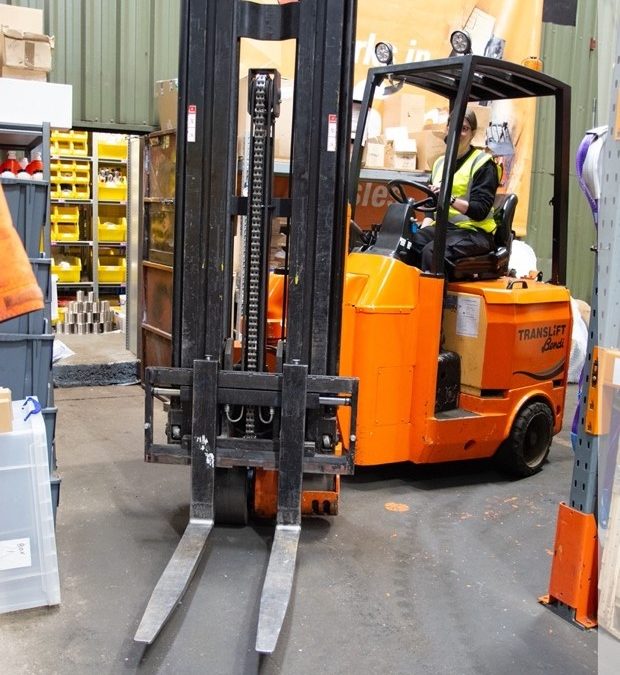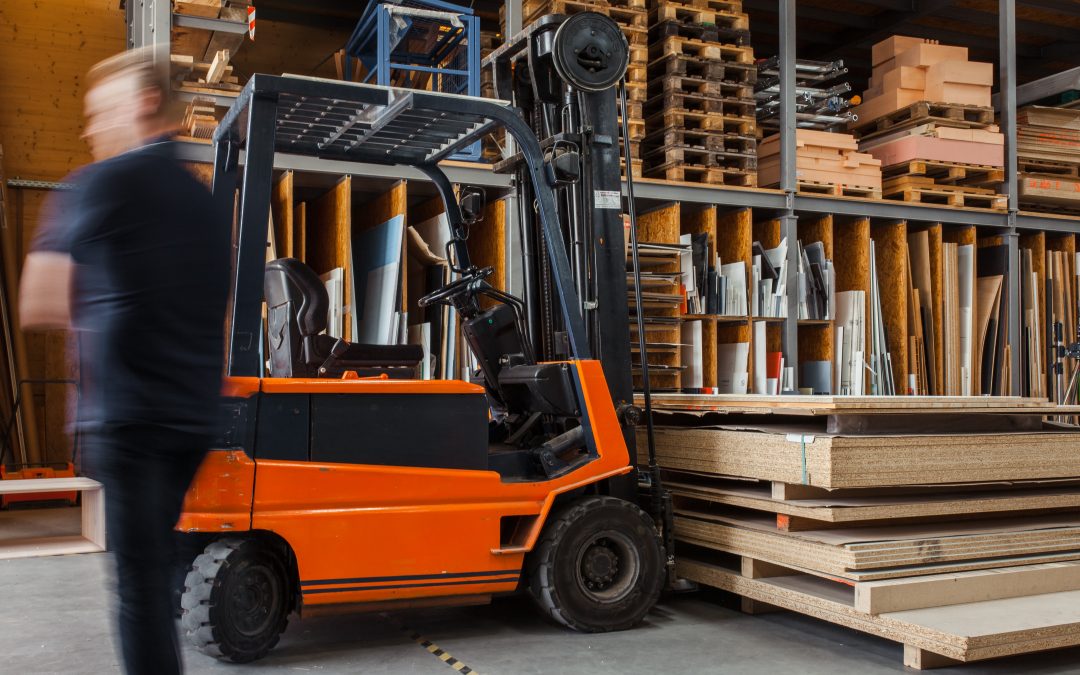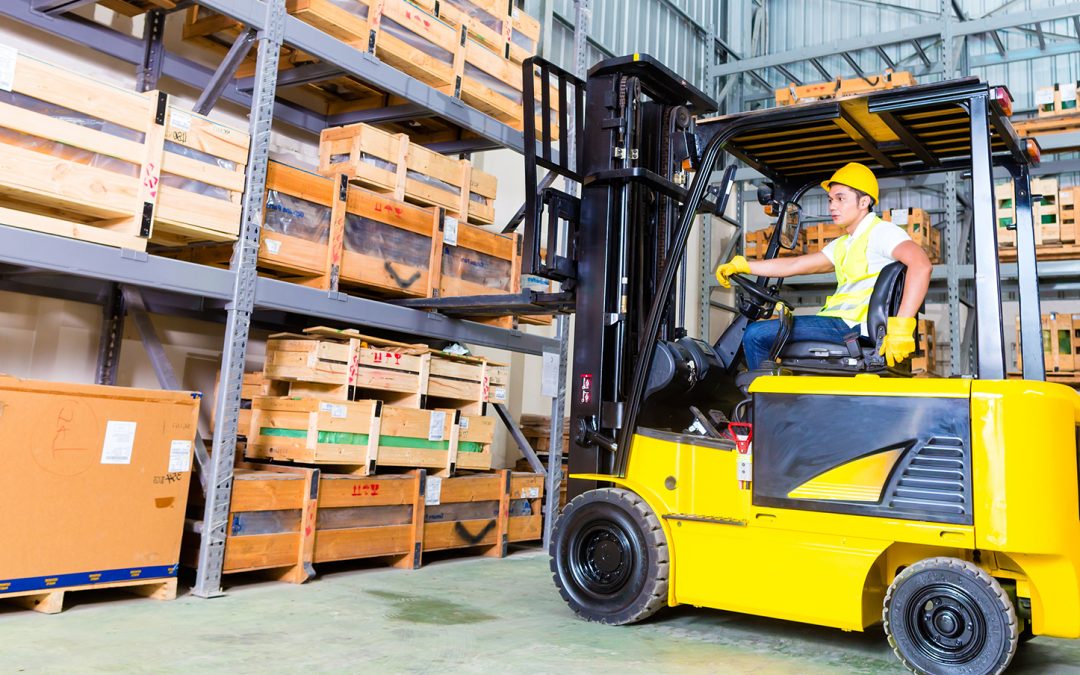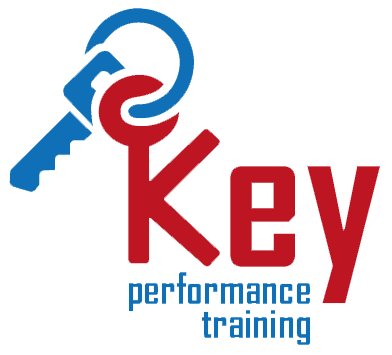
by Rachel Gearon | Oct 20, 2022 | Employment & skills, Industry news, Training courses
The UK has seen an increased demand for Pivot Steer operators, and this looks likely to continue.
There has been a 23% increase in Pivot Steer operator training compared to pre-pandemic levels, as employers look to create high density racking in their premises and maximise the efficiency of their operations.
The Pivot Steer, due to it’s ability to turn in very tight spaces, offers the best option for these types of environments but as an articulated machine, it’s very different to ‘standard’ counterbalance lift trucks, so different operator training is needed, even for experienced operators.
Our Pivot Steer Conversion course covers the basic principles of Pivot Steer operation – such as manoeuvring, stability fundamentals, stacking and destacking.
“Most Pivot Steer trucks are used to work with loads in high density racking systems. Here, there may be big differences in the tasks required and lift configurations,” says Laura Nelson, Managing Director for RTITB. “It is the responsibility of the employer to deliver training that applies to the specific situation that the operator will be working in, accounting for the complexities of the tasks at hand, and the specific type of equipment that will be used in the live environment.”
So if you’re looking to convert your existing certificate to one of these sort-after trucks, we’re delighted to confirm that courses are now available. Even better, if you book and attend a course in 2022, you can save 22% off the cost of the course!*
*Normally £285 plus VAT (£342 including VAT) – book a course for 2022 for £222.30 plus VAT (£266.76 including VAT). Quote “KPTPIVOT22” to use this offer.
Contact us on 01793 975353 or david.gearon@keyperformancetraining.co.uk for more information.

by Rachel Gearon | Sep 15, 2022 | Employment & skills, Industry news, Training courses
Operating a forklift looks straightforward. In fact, many people believe that if you can drive a car, you can drive a forklift. But it isn’t that simple. Operating a forklift requires an entirely different driving style to any other vehicle, which is only taught with specialist training. To help clear any rumours you might have seen on social media, here’s the most common misconceptions about driving a forklift that you need to know before starting your training.
You need to have a driver’s license
It might sound strange, but you don’t need any kind of specialist license to operate a forklift. That includes a driver’s license, so even if you can’t drive a car, you can still apply to be a forklift operator. If you attend regular training sessions to help you understand how to use the machinery safely, you’ll be good to go.
Forklifts are just like driving a car
Forklifts have four wheels and an engine, so it must be like driving a car, right? Wrong. That’s about as far as the similarities go, which is why you need to attend a training course to learn the ins and outs of forklift operation. Unlike any other vehicle, a forklift uses its rear wheels to steer. They also have a three-point suspension system, which means they handle very differently from any car, van, or lorry you might drive. If a forklift isn’t driven in the correct way, there’s an increased danger of swinging out and causing damage or injury.
Forklift training is just learning to drive forwards
Though you’ll learn how to safely drive a forklift forwards, that isn’t the entirety of the training course. You’ll find that much of your training will be spent driving in reverse, with professional instruction and practice helping you to move through the warehouse safely.
You’ll also be taught how to drive with a load on the front of your forklift and how to carry out the essential safety checks before climbing into the driving seat.
Forklift training takes a long time
Despite the many components to forklift training, a course can be done in just 3-5 days. This allows enough time to cover the theory, technique, and safety before focusing on the practical driving time.
So, if you’d like more advice on forklift training, please get in touch today.
Contact us on 01793 975353 or david.gearon@keyperformancetraining.co.uk for more information.

by Rachel Gearon | Sep 1, 2022 | Employment & skills, Industry news, Training courses
Did you know that the Provision and Use of Work Equipment Regulations 1998 (PUWER) requires all those who supervise lift truck operations to be adequately trained?
RTITB Managing and Supervising MHE Operations eLearning is perfect for anyone looking to develop into a managerial or supervisory role within an MHE environment, and for those already in the role looking to improve their understanding of their duties.
This course can be completed in a day, accessed on mobile devices, and will ensure you and your business are safe and compliant.
Contact us on 01793 975353 or david.gearon@keyperformancetraining.co.uk for more information.

by Rachel Gearon | Jul 21, 2022 | Industry news, Training courses
1,500 injuries are caused by forklifts and other industrial vehicles every year. Whilst unavoidable accidents can happen, many accidents occur because of poor operation or negligence – things that can be easily avoided.
Overloading a forklift truck is a key example of negligence which can cause unnecessary danger and accidents. Overloading a forklift truck results in the forklift tipping and falling, which causes damage to both the vehicle and stock but most importantly, the individual operating it.
Nearly one in every four fatalities occur when forklifts tip over. Forklifts can easily tip if they are overloaded, if the load is not well balanced, or if they travel with the forks too high.
Don’t push the limits
Most forklift operators understand the capacity of the machines they use and the importance of sticking to them. However, it is not uncommon for those who operate forklifts on a regular basis to become less strict with their weight load over time, attempting to put a little extra weight on to pallets or try to estimate the load sizes rather than weighing them.
Counterbalancing loads
Counterbalance forklifts are designed to balance the weight of the forks plus the load with the weight of the truck itself held by the back axle. With the weight of the truck offsetting the load, specific limits are required to keep the back of the forklift heavier, and the back wheels firmly on the ground.
When a forklift is static it may look balanced with its rear wheels on the ground, but add speed, turning, lifting and moving into the mix and this is when your counterbalanced weight will feel the effects. This is then worsened by things like terrain and incline.
Establish weight loads
Once you establish the load capacity, you should always strive to ensure you only load the forklift with loads within this. The weight of the load can be found by its labelling, or by manually using a weight scale.
If you’d like to ask us any questions about this, or need help training your staff to operate safely, please call us on 01793 975353 or email @ david.gearon@keyperformancetraining.co.uk.

by Rachel Gearon | May 19, 2022 | Employment & skills, Industry news, Training courses
Recent events have had a big impact on the culture of businesses, and our industry is facing skills shortages. It’s never been more important for businesses to embrace Equality, Diversity and Inclusion (EDI).
As employees return to work, training schedules kick in, and recruitment continues, it’s a great chance for logistics and supply chain employers to embrace EDI. EDI brings benefits to development, retention, and employee engagement.
Here are 4 ways that implementing EDI strategies could benefit your business and your employees.
- Address staff shortages
The demand for talent is high, opening up your workforce to under-represented groups can help fill skills gaps. For instance, women may avoid entering the logistics industry because of the attitude they fear they may encounter in a sector where male workers still make up 83.4% of the workforce.
When companies show inclusivity to all genders through language, behaviour, and policy (such as maternity leave, childcare support and extra support to those going through menopause), it can encourage more women into roles.
Similarly, today’s younger professionals may feel that logistics isn’t an attractive career option. Newer generations are more attracted to working for a business that has a culture that reflects their own. This includes a positive attitude to EDI – pay and career development alone, aren’t enough.
- Harness new skills and perspectives
Neurodiversity refers to a range of commonly co-occurring ‘conditions’ related to cognitive differences, and behavioural traits. It includes Dyslexia, Autism, ADHD, and more. Embracing neurodiverse people in the workforce creates an opportunity to incorporate a mix of talents, perspectives, and skills.
Employers should put their EDI initiatives into practice when considering how to support neurodiverse employees so that they feel able to thrive. This might mean taking a different approach to training. By asking trainees about their preferred methods of learning it can show that you understand that people think and learn differently.
More and more people are realising that they don’t have to stay in a job where they don’t feel respected and safe, nor should they have to. The good news is that EDI can lead to higher levels of staff retention.
Employers could consider, for example, if there is a need to address unconscious bias. Unconscious bias is when we make snap judgments about people based on our background, experiences, stereotypes and cultural context. Bias can be triggered by gender, ethnicity, disability, body weight, names, and many other things.
To create a more inclusive and tolerant work culture, employers should take steps to eliminate unconscious bias. This can be a topic included in training. Leaving areas like this unaddressed can make your staff leave. Importantly, employees who are treated fairly will tell prospective employees, supporting recruitment.
Good communication is key and taking a different approach to EDI can put this into focus. Training Managers, Instructors, and Warehouse Managers must be trained to communicate respectfully with trainees. This enables successful training. In a diverse workplace, trainers can improve communication by choosing different words. Talking in a way that makes different training candidates feel comfortable is important.
Remember, communication doesn’t just mean conversations. Communication also covers written materials used around the workplace. Keeping EDI in mind when developing written documents will help create better conversations throughout the company. This can help improve employee engagement.
It’s time to create a respectful and tolerant culture in your business. Now is the time to embrace EDI and create a culture that breeds respect. Make it clear to everybody that the business will not tolerate certain language and behaviours. Remember a work culture starts from the top, so practice what you preach.
Coming soon….Join us for our Launch Event at our new premises on 17th June 2022

by Rachel Gearon | May 5, 2022 | Employment & skills, Industry news, Training courses
Accidents involving materials handling equipment (MHE) are largely avoidable, yet still far too widespread in supply chain operations. With reach trucks one of the most common types of lifting equipment in use, the RTITB have recently launched the RTITB Reach Truck Operator’s Safety Code to help in house operations and training providers provide clear guidance on how to operate safely.
Below are ten of the simplest ways to help improve safety for Reach Truck Operators, and those around them:
- Never operate a truck you’re not qualified to – Operators should never be asked to operate a reach truck on which they have not been trained and authorised. This includes using a reach truck category that they are not specifically qualified for. Safe operation guidelines will vary for different types of reach trucks, so it cannot be assumed that competence on one type will ensure safety when using another.
- Use the correct truck for the application – One reason that there are so many distinct types of material handling equipment available is that some machines are better suited to certain tasks than others. Employers and operators should ensure that where a reach truck is being used, that it is the correct type for the environment and situation where it is working.
- Be ‘fit’ to operate the truck safely – It should be obvious that operators should never use a reach truck if they are under the influence of alcohol or drugs. However, this also includes strong medicines that may cause drowsiness. Operators that are unwell or overtired should avoid operating this type of equipment to ensure safety.
- Prioritise awareness – Awareness of the working environment is always the first line of defence against incidents. Operators should be trained to always pay close attention to what is going on around them. Phones or handheld devices should not be operated when an operator is in control of a reach truck. And operators that need to wear glasses should always remember to do so when operating the equipment.
- Know the signs – Operations differ in terms of traffic flows so operators should not only be aware of the site-specific rules, but should also maintain an awareness of safety signs, traffic lights, signals, and speed limits. Where there are none, operators should make use of hand signals, safety lights, audible warning devices and verbal communication to make their intentions clear to those around them to support safety.
- Remember – the forks are sacred! – The forks of a reach truck are only there to do the tasks they have been specifically designed for. It is extremely dangerous to let passengers ride on the reach truck or the forks. Operators should never lift anyone on the forks, on any attachment, or on the pallet, or allow anyone to mount these. Likewise, no-one should ever stand or walk under raised fork arms, even if the truck is unladen.
- Be aware of pedestrians – Pedestrians are highly vulnerable in workplace transport operations and are too often involved in incidents involving materials handling equipment. So, if there may be pedestrians in the area, reach truck operators must always drive slowly, carefully, and responsibly, even if they cannot see other people in the vicinity. Operators should keep an eye out for pedestrians appearing from blind spots, such as doorways or parked vehicles, and be prepared to make an emergency stop if needed.
- Be transparent about incidents – It is important for businesses to create a culture where incidents and near misses are reported openly. Even if no damage or injury resulted, it is vital to know about these events to take action to reduce future risk. If there is an incident, operators should be trained how to check that their truck is undamaged and functional before attempting to return to work, and to know what the procedure is should they identify and faults or damage.
- Take a break! The supply chain is under huge pressure now, with many staff working long hours. However, sitting and operating a reach truck from the same position for extended periods can lead to musculoskeletal problems and injuries. Ensure that operators take regular breaks and are encouraged to stretch and move around wherever possible. Otherwise, eventually, musculoskeletal disorders can equate to many lost working days in the operation.
- Make safety guidelines available – Good, professional practice is key to preventing incidents in the workplace, so it is helpful for operators to have easy access to clear safety guidance whenever they need it. The new RTITB Reach Truck Operator’s Safety Code is a convenient booklet and reference tool that enables reach truck operators to check in and refresh their skills and knowledge regularly and helps them make sound judgments in the common situations they encounter in the workplace.
Coming soon…. Three Time-saving Tips for Reach Truck Operator Training






